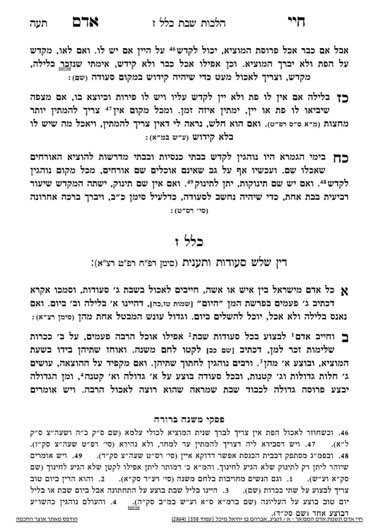The current series, which will cover seudos Shabbos and fasting on Shabbos, is available for sponsorship. Please contact Rabbi Reingold for more information.
We have begun Klal 7, which discusses the seudos of Shabbos, and are beginning siman 2. The Chayei Adam writes that every time a person makes a seudah on Shabbos, they are chayav to begin with hamotzi on lechem mishneh. Even if a person eats more than three meals, the chiyuv applies to those meals as well. The Gemara says that lechem mishneh is a mitzvah derabanan as a zecher to the man. A double portion of man was given on Friday for Friday and Shabbos, so to commemorate the man, we have a double portion of challah on Shabbos.
If a person does not have shleimim, there is still an advantage to taking two slices of bread rather than one.
When making hamotzi, the bracha is made on both breads, but it is sufficient to only break into one. However, there is an opinion (the Gra) that part of fulfilling lechem mishneh is to break into both of them, because breaking into both is a clearer commemoration of the double portion of man. Nevertheless, the Shulchan Aruch paskens that it is sufficient to cut only one.
If a person is only cutting one, it would seem that they should cut the one closest to them, to avoid the issue of ain ma’avirin al hamitzvos, to not ignore a mitzvah oportunity (see shiurim 1370-1379). However, kabbalistically, it is more appropriate to cut from the lower challah. In order to avoid any issues of ain ma’avirin, one should hold the lower challah a little closer to him rather than directly on top of each other. On Shabbos Day one cuts the upper challah. On Yom Tov, one cuts the upper challah for all meals (except if Yom Tov falls out on Shabbos. The halacha of lechem mishneh applies on Yom Tov as well, seeing that the man did not fall in the desert on Yom Tov either.
The Chayei Adam continues with a practical suggestion and writes that one can make challos of different sizes and use them together.
The Gra has an extraordinary opinion regarding the seudah. It is well known that the Zohar says one should say hamotzi on 12 challos. This seems to contradict the gemara, and there are those who understand it as such. Therefore, some people say hamotzi on 12 challos, following the Zohar.The Gra, however, is of the opinion that the Zohar and Halacha never argue, and one needs to find how they fit. He explains that between the three meals of Shabbos there are six challos, and by breaking into each one, a person creates 12 sections. Thus, the Gra understands that the 12 challos which are mentioned by the Zohar come out to be the same as the three times the Gemara says one should minimally fulfill lechem mishneh.
Summary
- One should have lechem mishneh at any seudah they make on Shabbos, even if they make more than three seudos.
- They should be shaleim (whole), but if they are not, it is still preferable to take two slices for lechem mishneh than just one.
- It is sufficient to break into only one bread, although some hold one should break into both.
- One should cut the upper challah, with the exception of Friday Night, when one should cut the lower challah. In order to avoid an issue of ain maavirin, on Friday Night one should bring the bottom challah a little closer to him



